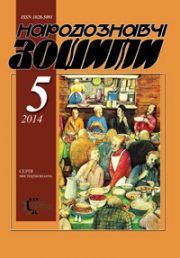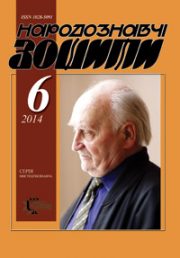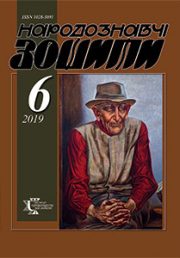The Ethnology Notebooks. 2024. № 3 (177), 518—531
UDK [94:39(470.62=161.2)]”19/20″
DOI https://doi.org/10.15407/nz2024.03.518
UKRAINIANS OF KUBAN: HISTORICAL AND ETHNOLOGICAL RESEARCH
AVRAMENKO Anatoly
- ORCID ID: https://orcid.org/0000-0003-2538-7195
- Candidate of History (Ph.D., National History),
- Krasnodar, Russia,
- Contacts: e-mail: shron2011a@gmail.com
Abstract. Introduction. The article is a brief outline of the ethnic history of the Ukrainian population of the Kuban region of Russia: stages of settlement, assimilation factors, economic activities, types of settlements, housing, clothing, food, social and family life, customs and rites, folklore. Attention is paid to methods of changing the ethnic composition of the population during the Holodomor of 1932—1933, mass deportations of residents of Ukrainian-speaking villages to the east and north of the USSR. Contemporary ethnocultural processes are considered.
The purpose of the article is to show the leading role of Ukrainians in the settlement and economic development of the Kuban in pre-revolutionary times, the use of Ukrainian Cossacks in the interests of imperial policy, attempts to separate the Ukrainians of the region from native Ukraine, measures to destroy the historical memory of local Ukrainians, the criminal ethnic policy of the Soviet government, consequences of this policy.
The object of the study is the Ukrainian population of the Kuban region from the end of the 18th century to the present, and the subject is the stages of settlement, assimilation factors, economic activities and elements of the culture of the region’s inhabitants, state policy towards the Ukrainians of the region.
During the study of the ethnic history of the Kuban’s Ukrainians, there were applied the methods of empirical (description based on sources and scientific literature) and theoretical research, in particular, comparative-historical, statistical and structural analysis.
The results. It has been proven that the Russian Empire successfully used the fighting potential of the Ukrainian Cossacks in order to conquer new territories, while at the same time trying to separate the immigrants from the cultural influence of Ukraine, to deprive them of historical memory. However, the number of Ukrainians in the Kuban region increased thanks to new waves of immigrants after the abolition of serfdom, self-consciousness remained Ukrainian. Attempts to use the «Ukrainization» of the local population in order to strengthen the Soviet regime were unsuccessful, so Moscow began to destroy everything Ukrainian: books, the press, schools, the national intelligentsia, the Chernomorian Cossacks. Mass terror, forced deportations, and the destruction of part of the Ukrainian population led to a change in the ethnic composition of the region. The modern descendants of Ukrainians rather consider themselves Kubans, the local «balachka» (speak) is gradually dying, but the remnants of historical memory remain, the awareness that the «katsaps» are strangers to the Cossacks and their descendants. However, the cultural and informational isolation of Ukrainians in the Kuban, Moscow’s propaganda contribute to a distorted perception of Ukraine among local residents. This is also an unfortunate consequence of the Ukrainian government’s indifference to the situation of Ukrainians in Russia.
Keywords: ethnic history, Kuban Ukrainians, types of settlements, housing, everyday life, folklore.
Received 6.06.2024
REFERENCES
- Bilyi, D. (1994). Malynovyi klyn (Raspberry wedge). (Essays on the history of the Ukrainian population of Kuban). Kyiv: Society «Ukraina» [in Ukrainian].
- Bilyi, D. (2005). Kuban and Ukraine. Pam’yatky Ukrainy: istorija ta kultura, ѕ, 2—47 [in Ukrainian].
- Bilyi, D. (2009). Ukrainians of the Kuban in 1792—1921: Evolution of social identities. Lviv; Donetsk: Eastern Publishing House [in Ukrainian].
- Petrenko, Ye.D. (1997). Migrant movement from Ukraine to Kuban (the other half of the 19th century — the beginning of the 20th century). Kyiv: Instytut istorii Ukrainy [in Ukrainian].
- Sergijchuk,V.(2014). The Northern Caucasus: Ukrainian aspects of settlement, development of the state and national knowledge. Kyiv [in Ukrainian].
- Suprun-Yaremko, N.A. (2003). Ukrainian subethnic group in Kuban. Kulturnaja zhizn’ Yuga Rossii, 3, 51—56 [in Russian].
- Suprun-Yaremko, N.O. (2010). «Repressed» historical songs about the 20—30s of the 20th century in Kuban. Kuban’ — Ukraina: voprosy istoriko-kul’turnogo vzaimodejstvija, 4, 115—125 [in Ukrainian].
- Goryn’, B. (2004). The tragedy of the Ukrainians of Kuban. Ukrains’ka diaspora v Posii: stan, problemy, perspektyvy: Materialy naukovo-praktychnoi konferentsii (22 grudnya 2003 r.) (Pp. 68—74). Кyiv: Ukrainian All-World Coordination Council [in Ukrainian].
- Skibitskaja, I.M. (2010). From the history of one correspondence, or Do the Consulate General of Ukraine in Rostov-on-Don need Ukrainians from Kuban? Kuban’ — Ukraina: voprosy istoriko-kul’turnogo vzaimodejstvija, 4, 326—335 [in Russian]
- Avramenko, A.M. (2023). From the kurens of the Zaporozhian Sich to the villages and cities of the Kuban region (problems of the origin of place names, historical geography, topography and cultural heritage). Moscow: Direct-Media [in Russian].
- Popka, I. (1858). Chernomorian Cossacks in their civil and military life. Sankt-Peterburg [in Russian].
- Boeck, B.J. (1999). The problem of ethnic and estate differences in Kuban in the second half of the 19th century (according to the memoirs of F.A. Shcherbina). Kuban: problemy kultury i informatizatsii, 1 (12), 40—42 [in Russian].
- Klimchuk, F.D. (2008). Settlement of ethnic Ukrainians in the South and South-West of Russia (based on the 1926 census) Kuban’ — Ukraina: voprosy istoriko-kul’turnogo vzaimodejstvija, 3, 257—285 [in Russian].
- Sadylenko, M. The persistence of the Kuban language. Pam’yatky Ukrainy: istorija ta kultura, 3/4, 48—55 [in Ukrainian].
- Shalya, I. Ukrainian literary language and language of the Kuban region. Pam’yatky Ukrainy: istorija ta kultura, 3/4, 56—59 [in Ukrainian].
- Gangur, N.A. (2008). Traditional dwelling of the Chernomorian Cossacks (building materials and technologies, layout and interior. Kuban’ — Ukraina: voprosy istoriko-kul’turnogo vzaimodejstvija, 3, 93—110 [in Russian].
- Gangur, N.A. (2009). Material culture of the Kuban Cossacks (Vol. 1—2). Krasnodar [in Russian].
- Chistov, K.V. (Ed.). (1967). Kubanskiye stanitsy: Etnicheskije i kul’turno-bytovyje protsessy na Kubani (Kuban villages: Ethnic and cultural processes in Kuban). Moskva: Nauka [in Russian].
- Chernij, K.N. (1883). Yeisk district (Statistical description) Kubanskij sbornik, 1, 338—547 [in Russian].
- Bondar, V.V. (2008). Ukrainian Baroque in the architecture of Kuban at the end of the 18th — first half of the 19th century. (formulation of the problem). Kuban’ — Ukraina: voprosy istoriko-kul’turnogo vzaimodejstvija, 3, 87—92 [in Russian].
- Gangur, N.A., & Shapovalova, A.V. (2011). Traditional costume of the Chernomorian Cossacks (late 18th century — 1860). Krasnodar [in Russian].
- Sharapova, M.V. (2011). Ukrainian traditions in the clothing of the East Slavic population of Kuban in the second half of the 19th — early 20th centuries (diachronic analysis) Kuban’ — Ukraina: voprosy istoriko-kul’turnogo vzaimodejstvija, 5, 98—108 [in Russian].
- Bondar, N.I. (Ed.). (2005). Ocherki traditsionnoj kultury kazachestv Rossii. (Essays on the traditional culture of the Cossacks of Russia) (Vol. 2). Moscow; Krasnodar [in Russian].
- Kontsevich, G.M. (1913). Chumaks in folk songs: Excerpts from a report read at the general meeting of members of the Society of amators of the Study of the Kuban Region on April 5, 1913. Izvestija Obshchestva lubitelej izuchenija Kubanskoj oblasti, VI, 167—190 [in Russian].
- (2001). Kuban folklore and ethnographic expedition A/k.-2328. Krasnodar region, st. helbasskaja, inf. — Kaban N.Ye., born 1925, Kaban T.N., born 1921, Shinkarenko G.F., born 1913, research. — Matveev O.V. [in Russian].







